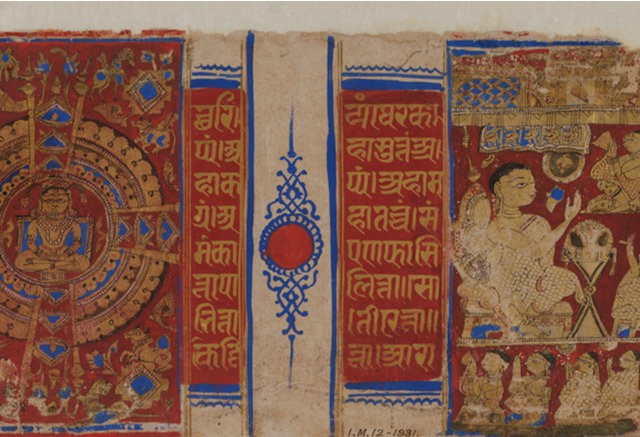Video:
Vinod Kapashi: Jain manuscript paintings from Victoria and Albert Museum on Vimeo.
Jain Manuscript Paintings from Victoria and Albert Museum

Hello. My name is Vinod Kapashi. I live in London. I take a keen interest in Jainism. I have done a PhD in Jain studies. Here are some of my favourite objects, so to speak. These are actually folios from manuscripts. Here we have got a piece from a manuscript which is my favourite one. This is called the Kalpa Sutra, now one of the sacred texts from the Jain canon. This manuscript was written in the state of Gujarat in India in the 15th century. It's on paper, but one can see the beautiful painting on this manuscript, especially on the left hand side you can see the Lord Mahavira, the 24th and the last Tirthankara, enlightened soul who lived on this earth, is seen here. The Lord Mahavira is sitting in an assembly hall. The assembly hall has got three circular walls and there are four gates which lead into that assembly hall. Mahavira is seated on a raised platform in the centre. Animals, people and even semi-gods, they all go to hear his discourse. So this is very important as far as Jain is concerned, the writing is in the language which is called Prakrit Ardhamagadhi language which prevailed during the time of Lord Mahavira. Again, the writing is done in a golden ink.
Here is another miniature painting. Lord Mahavira is seated here and the monks, the group of monks are sitting and listening to his discourse. The manuscript, obviously it is not in a perfect and very good condition, but you can even see, here they used to make a hole where the thread will go through and they used to bind the manuscript. Rich merchants in India used to commission such works and once the manuscript was ready, they used to present this manuscript to monks and monks used to read this manuscript during the holy festival of Paryushana and then they would deposit in a Jain library so that was preserved in a Jain library in the late 19th century and has been brought here after that period.
Here we have another beautiful example of the manuscript of Kalpa Sutra. This manuscript was again written in the late 15th century in the state of Gujarat. Here one can see the mother of Lord Mahavira, Queen Trishala, lying on a couch and you can even see the child Mahavira lying beside her. A chauri bearer, her maid, is in attendance. And this manuscript, this picture, is drawn with a specially made golden ink. The real gold was used to make such inks, even the writing with the blue background, the writing is in a golden ink and again the same language has been used, the language is Ardhamagadhi Prakrit language. One can see the pointed nose, pointed eyes and pointed chin which is a speciality of all Jain manuscripts. So it's again, a beautiful example and beautifully preserved in this collection here.
This particular folio is from the manuscript of Uttaradhyayana Sutra. The Uttaradhyayana Sutra is the last sermon of Lord Mahavira. This particular text has got 36 chapters in it and the book itself describes the code of conduct for the monks. Each and every manuscript that has been preserved has got some sort of beautiful painting. This particular manuscript was written down in the state of Gujarat in the mid 15th century. Here one can see three different pictures. The one at the bottom is a very important one. When Lord Mahavira became a monk, he went to the jungle, he gave up everything. He removed his possessions, his jewellery and all that he had got and he plucked his hair out. That was symbolical for a Jain to become a monk. So that depicts that he became a monk. The manuscript has got the writing in black ink and the writing is again in the language which was prevalent during the time of Lord Mahavira. It's called Prakrit Ardhamagadhi language.
Here is a picture of a woman teaching her child and the father of the child is in the background. It is believed that this is Queen Trishala, King Siddhartha and the child Mahavira have been depicted in this picture. These two fishes are important. Most Jains believe in the transmigration cycle, samsara and the samsara is compared with the sea. So we are swimming in this sea until we get to nirvana or moksha. So this is a sea and one is swimming in the sea of samsara. That is why it is important.
 Dr. Vinod Kapashi
Dr. Vinod Kapashi